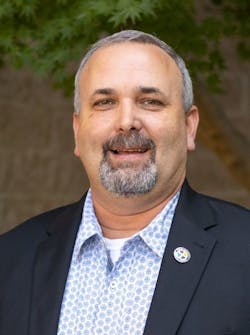Q&A: Terry Scoggin, CEO of the Last Independent Hospital in Northeast Texas
Titus Regional Medical Center in Mt Pleasant, Texas, near the Arkansas, Oklahoma and Louisiana borders, serves five counties and is the last independent hospital left in Northeast Texas. Titus’ CEO Terry Scoggin recently spoke with Healthcare Innovation about the health disparities in rural Texas communities and some of the ways he is using data to garner support for a community-focused approach to improvement.
HCI: Could you talk about your experience during the pandemic and how it has shaped some of your thinking about health equity?
Scoggin: “There are 35 counties in Northeast Texas, and 26 of those do not have a public health department, so during COVID our hospital was the health department. The state tries their best, and I thought they did a great job of helping us during COVID. But we didn't have a health department, so we're on our own. During COVID, we worked with our community and our doctors and built a model that I think worked the right way. We had the highest rate of COVID infection per 100,000, but we had the lowest mortality in Northeast Texas by half. It was still greater than the state's average. But from a Northeast Texas perspective, which is a different demographic, we were able to save hundreds of lives. Coming out of that, my counterparts here at the health system and I realized we have an equity issue. We wanted to use the same mentality that we did during COVID to address the inequities in healthcare in our area. COVID opened our eyes to a lot of different cultures and a lot of different issues.
HCI: What are some of the ways equity issues are different in the rural setting than they would be in Houston or Dallas?
Scoggin: In a rural setting, we have an older population, with more chronic conditions. We have a higher number of people with two or three comorbidities such as high blood pressure and obesity. We also have less education and higher poverty. Thirty-one percent of the adults in the community are uninsured. Health literacy is a factor. Also, our community is 47 percent Hispanic.
Adding to that challenge, we also have limited access to primary care and specialty physicians. I mentioned that we don't have a health department, so nobody's focused on preventive health.
HCI: You mentioned being the last independent hospital in Northeast Texas. Can you talk about why that is?
Scoggin: The Texas Hospital Association really supports rural hospitals, but to complement that we have the Texas Organization of Rural Community Hospitals, or TORCH. It is an advocacy group for 158 rural hospitals in Texas. We've seen 27 closures in Texas, so we are at risk. We've seen four hospitals closed within 35 miles of us since 2014. The rest of them have joined large health systems.
HCI: Do you get approached by large health systems about acquisition or partnerships?
Scoggin: Every day. I have a meeting next Tuesday night, and there'll be a contract on the table, but the large health systems don't understand why we want to be independent. We have our reasons, but it's going to be hard. We believe COVID was a great example of that. And now with this whole equity push, and addressing health disparities — if we were part of a large corporation, I would have to ask permission for this. It'd be difficult. I have a seven-member elected board of managers who I report to. Decision-making is pretty simple.
HCI: I understand that you did a deep dive on health data in rural Texas and developed a rural Texas benchmark. I read that you use a tool from Metopio that provides data, analysis and visualization. Can you talk about how you use that?
Scoggin: We can argue feelings all day long. We really can't argue data. The numbers really say a lot. They show you the right direction. We looked at all the counties that were both above and below 60,000 in population and used the Metopio tools to create a rural disparity benchmark. I'm able to look at mortality for rural compared to urban. When you look at Texas overall, we're close to the national averages, but we're really not. Without this visualization, you wouldn't be able to see exactly what we're talking about. For instance, you can look at urban vs. rural Texas in terms of OB/GYN per capita, and see what they are talking about when they use the term “maternal desert.”
HCI: What else can you do with this type of data and the maps you’ve created?
Scoggin: With our local government’s support, we have started a Titus County Wellness Coalition. We’ve got 40 community members coming together to try to be our health department for Titus County. My goal would be to get a health department funded at one point, but at a minimum apply for grants. The data is instrumental because I'll be able to create a whole package that explains our service area, that explains rural vs. urban, and I think that will go a long way with grant and financial support from the state. I have an intern starting this summer and she's going to use this tool to put together our wellness coalition’s needs assessment.
Once you see this data, and once you start talking to people in the community, you can't unsee this. Your passion changes. The African American community looks different than the Hispanic community, different than your Caucasian community. I didn't know we had a Vietnamese community in our county until we started this process. Then I realized we had about 500 or 600 Vietnamese people who go to Dallas for all their healthcare because none of our providers speak Vietnamese.
When the Joint Commission came for an audit, they wanted to see what we were doing in our board meetings related to health equity, and they asked my board members. The good news is we've been talking about this for the last 12 months. My board members knew about it. They've seen the data from Metopio. They all knew about what we did with the city in terms of trying to break down our census tracts. The Joint Commission asked some great questions and they wanted to see how we had moved into equity in every part of our health system.
HCI: Will Snyder, CEO of Metopio, has joined the conversation. Will, could you talk about how another rural health system is using your tools to unlock insights?
Snyder: Yes, Duncan Regional Health, which is in Oklahoma, is another rural critical access health system that's been using Metopio in a lot of analogous ways to what Terry outlined — just being able to do those place-based population assessments, and really thinking about the issues they face in their community. They also used it to work on Joint Commission reporting. They use Metopio’s visualizations for their grant applications. When they're applying for federal and state dollars, they're able to very quickly say, here's the population, here are the stratifications, here are the outcomes, and this is why we need x millions of dollars to build whatever service line. So grant support is something we're seeing more and more of.


